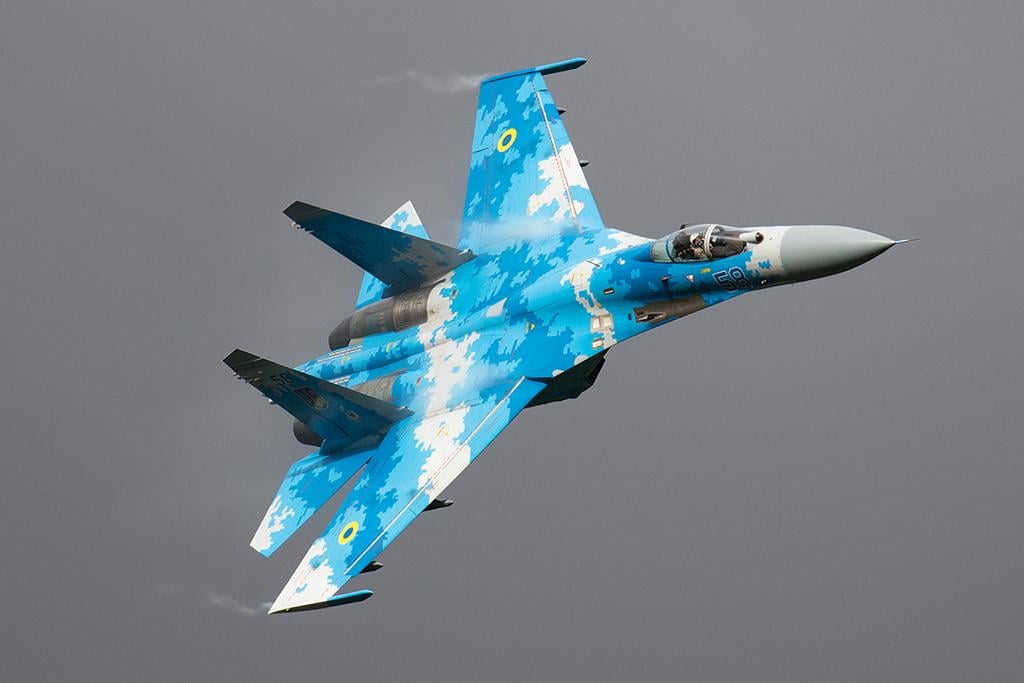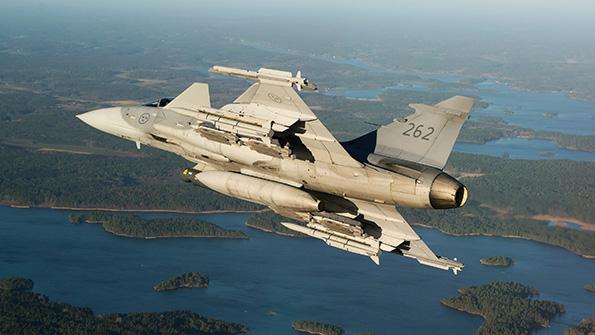
Ukrainian Su-27 “Flankers” like this one have been outmatched and outnumbered by Russian Air Force Su-30s and Su-35s.
Ukraine will need Western-made combat aircraft if it is to resecure its skies against Russian invaders, an examination of the air war over Ukraine has concluded.
Kyiv’s ground-based air defense missiles have done well in repelling air attacks and preventing the Russian Air Force from achieving air superiority. But Moscow’s use of long-range cruise and ballistic missiles as well as Iranian-supplied loitering munitions—the latter launched a dozen at a time—could quickly dwindle stocks of Ukrainian surface-to-air missiles (SAM) and those now being supplied by Western allies.
- Advanced Western fighters could be a deterrent to Russian air attacks
- Reports suggest Moscow is short of weapons
Such a game of attrition could allow the Russian Air Force to operate freely in Ukrainian airspace, a report written by the London-based Royal United Services Institute (RUSI) think tank warns.
“If Ukrainian SAMs are allowed to run out of ammunition, the Russian [Air Force] fixed-wing fleet would suddenly again be able to start penetrating deep into Ukrainian-controlled airspace at medium and high altitudes,” authors Justin Bronk, Nick Reynolds, and Jack Watling state. Their research, some of the most in-depth into Russia’s air war over Ukraine, suggests that Kyiv’s fighter forces—which include early-model Russian Aircraft Corp. MiG-29 “Fulcrums” and Sukhoi Su-27 “Flankers”—would be overmatched and outnumbered by more advanced Russian foes such as the Su-30SM and Su-35S, thanks to their advanced radar systems and longer-range and more capable air-to-air missiles.
Despite throwing some 350 combat aircraft into the air campaign, Russia failed to capitalize on its airpower advantage and has suffered heavy losses, due largely to Ukrainian ground-based air defenses—and from man-portable surface-to-air missiles when Russian pilots transitioned to low-level operations to avoid more capable systems.
On Nov. 3, Gen. Valeriy Zaluzhnyi, commander-in-chief of the Ukrainian Armed Forces, asserted that Russia had lost over twice the number of aircraft in the Ukraine air campaign than it had during the Soviet-Afghan War.
Russian helicopter fleets have suffered as well. The UK Defense Ministry reported on Oct. 25 that Russia had lost a quarter of its fleet of Kamov Ka-52 “Hokum” attack helicopters during operations in Ukraine.
Reports suggest that Moscow is now facing shortages in weapon stocks and will struggle to replace the aircraft it has lost, forcing it to turn to the few allies it has left.
“Failure in the air domain has prevented [Russian forces from] securing necessary superiority, let alone supremacy, and thus they cannot provide the required support to their land forces,” Royal Air Force Air Marshal Johnny Stringer, deputy commander of NATO’s Allied Air Command, told RUSI on Nov. 3. This failure, he added, means Russian ground forces “do not have the necessary freedom of maneuver, let alone air-delivered support to prosecute the ground fight from [as] close to deep as they would wish.”

Despite the Russian Air Force’s failings in the conflict, the authors warn that Western governments should not be complacent. “The underwhelming [Russian Air Force] fighter performance during the first days of the invasion is unlikely to be repeated if Ukrainian SAMs are starved of ammunition to the point that they can no longer deter Russian fixed-wing incursions,” the report states. It notes that Russia’s inability to undertake complex suppression and destruction of Ukraine’s air defense network has allowed Ukraine to make the war gains it has so far.
“It is vital that the West does not lose sight of the fact that it must help Ukraine to keep that air defense network supplied and reinforce it,” the RUSI report argues.
Even now, interceptions of Iranian-built Shahed-136 loitering munitions use missiles that cost more than the reported $20,000 price of the drone (AW&ST Oct. 10-23, p. 32). While not difficult, the report states, most of the current means of interception “are too expensive or draw on unacceptable numbers of weapons required for other defense tasks to provide an adequate medium-term solution.” A near-term solution to the Shahed-136 problem would be more self-propelled anti-aircraft guns such as the Gepard systems provided by Germany.
The report also suggests that missiles for Ukraine’s own ground-based air defense systems, such as its domestically upgraded S-300 and Buk systems, also need to be replenished after “eight months of high-intensity combat have consumed unprecedented and unforeseen quantities of interceptor missiles.” However, limited industrial capacity in Ukraine and in the West means these missiles may be difficult to replace quickly, potentially affecting Ukraine’s ability to expand its air defense coverage (AW&ST Oct. 24-Nov. 6, p. 36).
The authors say the West needs to step up not only deliveries of ground-based air defenses and missiles but also advanced weapons that can be used by Ukrainian Air Force combat aircraft. Ukrainian MiG-29s and Su-27s have been given an ad hoc suppression-and-destruction-of-enemy-air-defense capability through the integration of the U.S. Raytheon AGM-88 High-Speed Anti-Radiation Missile, an effort carried out in eight weeks by an undisclosed industry partner.
The RUSI report suggests more standoff weapons will be needed to increase the survivability of what remains of Ukraine’s combat aircraft fleet. But the limited time and the inability of Ukrainian aircraft avionics to work with Western weapons makes integration problematic and requires the Western-made weapons to be “programmed with the release and target parameters before being loaded onto the fighter,” the report says.
With Russian forces expected to re-mass in 2023, the authors suggest the U.S. CBU-105 Sensor-Fuzed Weapon could be adopted as a potential munition for Ukraine’s Su-24 “Fencer” fighter bombers so that they can attack massed Russian vehicle formations.
In the medium term, the report contends, Ukraine needs to be supplied with Western fighters, “to meet Russian fighters on more equal terms . . . [and] if providing sufficient ammunition to maintain frontline SAM coverage proves difficult.”
These fighters would need to be equipped with long-range air-to-air missiles that can be launched from a low level as well as with advanced electronic warfare capabilities to reduce the effectiveness of Russian air-to-ground and anti-ship missiles and radars at long range. The authors point out that Sweden’s Saab Gripen fighter could be ideal for Ukraine. Developed as a low-cost platform, the Gripen can make use of long-range missiles such as the MBDA Meteor beyond-visual-range air-to-air missile and was designed to be operated from austere environments including road runways, a mode of operation Ukraine has had to adopt for its Fulcrums and Flankers. The Gripen can also be supported in the field by conscripts.
However, attempts by NATO countries and even European Union officials to deliver combat aircraft to Ukraine, including types such as the MiG-29 that remain in service or are being withdrawn from NATO member states, have not been allowed to progress. Even the U.S. government has repeatedly refused Ukraine’s requests for surplus U.S. fighters, including Fairchild A-10s and Lockheed Martin F-16s, possibly fearing that such a move could be escalatory.
The report maintains, however, that even just a few deliveries of Western fighters equipped with long-range missiles able to meet the Russians on technically equal or even superior terms “would likely have a disproportionate deterrent effect.”
Without the fighters, as well as deliveries of more Western SAMs, the RUSI authors assert that the Russian Air Force can still pose a threat to Ukraine’s military, infrastructure and civilian populations “if given an opening.” A Russian sustained strike campaign, they say, could, if unopposed, “thwart the dominant battlefield momentum that Ukrainian troops have fought so hard to win.”






Comments
A few Wild weasels even old F-15's could nail his remote launch sites and shut down the missile attacks